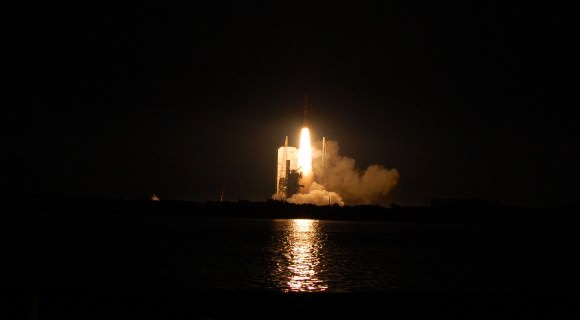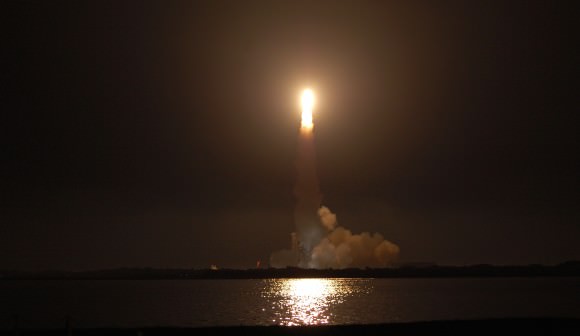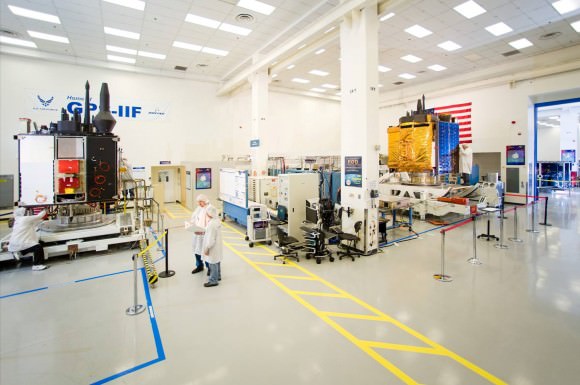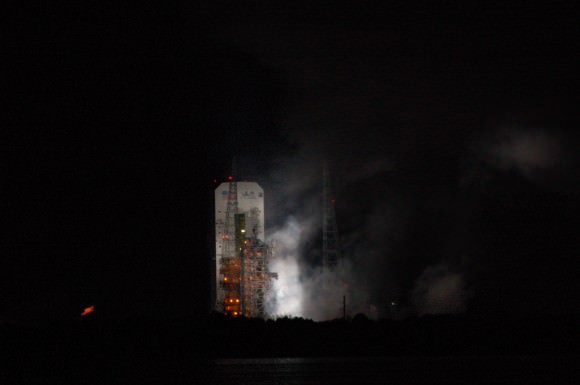[/caption]
CAPE CANAVERAL, Fla. – The U.S. Air Force launched the GPS IIF-2 satellite into orbit Saturday (July 16) on a mission to enhance the country’s constellation of Global Positioning System satellites. The satellite was launched atop a Delta IV Medium 4, 2 rocket from Cape Canaveral Air Force Station’s Launch Complex 37B at 2:41 a.m. EDT. The Delta IV had been scheduled to launch two days prior but slipped one day due to a technical issue with the satellite and a second day when technicians were prevented from rolling the Mobile Service Tower or MST back because of weather.

This morning’s launch
The rocket was provided by United Launch Alliance (ULA) and the company oversaw the liftoff. This configuration of the Delta IV Medium has two solid rocket boosters which are provided by Utah’s Alliant Techsystems (ATK). The boosters are required to provide the extra boost required to send the spacecraft into the correct orbit.

Weather was the biggest concern for the launch, but when the clock reached zero the launch vehicle thundered off of the pad in a spectacle of sound and light. The weather turned out to be a non-issue with mostly clear moonlit skies and almost no breeze. Lightning could still be seen lighting up the Florida sky off in the distance – but the summer light show only served as a backdrop for the launch.
“This is an exciting time for ULA, we are happy to have launched our 52nd mission,” said United Launch Alliance Spokesman Chris Chavez. “We’re happy to support the U.S. Air Force along with our customer and partner Boeing – it was a great launch and a great morning.”

The satellite
Boeing is the prime contractor that provided the U.S. Air Force with the GPS satellite. The GPS IIF system is expected to provide next-generation performance to the GPS constellation of satellites. These abilities are considered to be vital to U.S. national security as well as maintaining the GPS constellation’s availability for civil, commercial and military requirements. The IIF is expected to provide enhanced capability and better performance.
The first GPS IIF satellite was launched in 2010. It is hoped that the pulse-line production method that is employed by Boeing will ensure that the IIF fleet is placed on orbit on schedule. This production method is very similar to how airplanes are developed. The process is named because satellites are moved from one work station to the next in a steady rhythm – similar to a pulse.
The GPS IIF-2 satellite will be utilized for both for civilian and military purposes. A new civilian L5 signal will assist with search and rescue missions, while the military will benefit from the satellite’s resistance to jamming. The satellite also has a reprogrammable processor that can receive uploads on-orbit. GPS IIF-2 has a design life of 12 years and it is hoped that it will provide long-term service will keeping operating costs low.
“The enhancements that the GPS IIF-2 satellite has should strengthen the constellation for many years to come,” said Boeing Spokesperson Angie Yoshimura.



I think the team who managed the rocket are Transformers fans!! (see link under)
http://www.tfw2005.com/transformers-news/other-news-20/delta-4-rocket-team-transformers-fans-172868/
*Wonders how much the US military could have saved by putting this on a Falcon 9 instead of a hyper-expensive Delta IV*
Can a Falcon 9 launch 3700 lbs to a 11000 mile high orbit?
Yes, a Falcon 9 can launch about 10,000 pounds to GTO. (Actually slightly less in practice, because they (and all other rocket manufacturers) like to leave a margin of error.)
Gopher652003 – There have only been two flights of the Falcon 9 – and both of those were test flights. The Falcon 9 hasn’t launched any payloads yet and if the U.S. Air Force and others want to maintain their launch manifest – they can’t wait.
Given that the Delta IV Medium 4, 2 also has two SRBS – I doubt the Falcon has the same lift capacity as it does.
Your right, the Falcon 9 has lower lift than the Delta 4,2
Here are the comparisons for GTO. Howerver GPS birds are closer to this, so milage will be better. Aprox mass of the bird is 1,630 kg.
Delta 4.2 to GTO = 6030kg From (http://www.ulalaunch.com/site/docs/product_cards/DIV_product_card.pdf)
Falcon 9 to GTO = 4680 kg from (http://www.spacex.com/falcon9.php)
Both could have done it, but as of right now SpaceX does not have the industrial capacity to crank-out hundreds of Falcons at the moment.
As for the mass descrepency, they may have piggybacked another payload since there is about 5-6 Tousand Kg missing in the payload and MTOs are less fuel intensive that Geosych orbits.
The ULA doesn’t have the capability to crank out hundreds of Delta IV Mediums either:P. They make and launch very few Delta IV rockets (it takes them between 1.5 and 2 years to manufacture any given rocket, depending on the type). They’ve averaged what, 2 launches a year for the past 10 years?
They’re also expensive even compared with their non-SpaceX competitors. Especially now that the ULA exists (Boeing and LM merged their rocket businesses into one, severely reducing competition in the US marketplace).
Here’s a great comparison of the various types of Delta IV rockets from Wikipedia. Are those SRB to scale? They’re tiny!
http://en.wikipedia.org/wiki/File:Delta_rocket_evolution.png
Gopher652003 – There have only been two flights of the Falcon 9 – and both of those were test flights. The Falcon 9 hasn’t launched any payloads yet and if the U.S. Air Force and others want to maintain their launch manifest – they can’t wait.
Given that the Delta IV Medium 4, 2 also has two SRBS – I doubt the Falcon has the same lift capacity as it does.
Likely $0
With a 40% overall failure rate and only two F9 demonstration launches under their belt it would be pretty foolish to put anything theAir-force actually wanted in orbit on a SpaceX vehicle.
SpaceX has gobs of wonderful PR but, they can’t talk a GPS into orbit.
They need to get 15 or so (my opinion) successive successful launches and orbital placements accomplished before the AF will trust them.
Far from one my best,But got the booster seperation,Delta4 medium,60 miles away,2:42am Est,7-16-11
Enjoy! Atlantis launch i was totaly covered in clouds 8^(